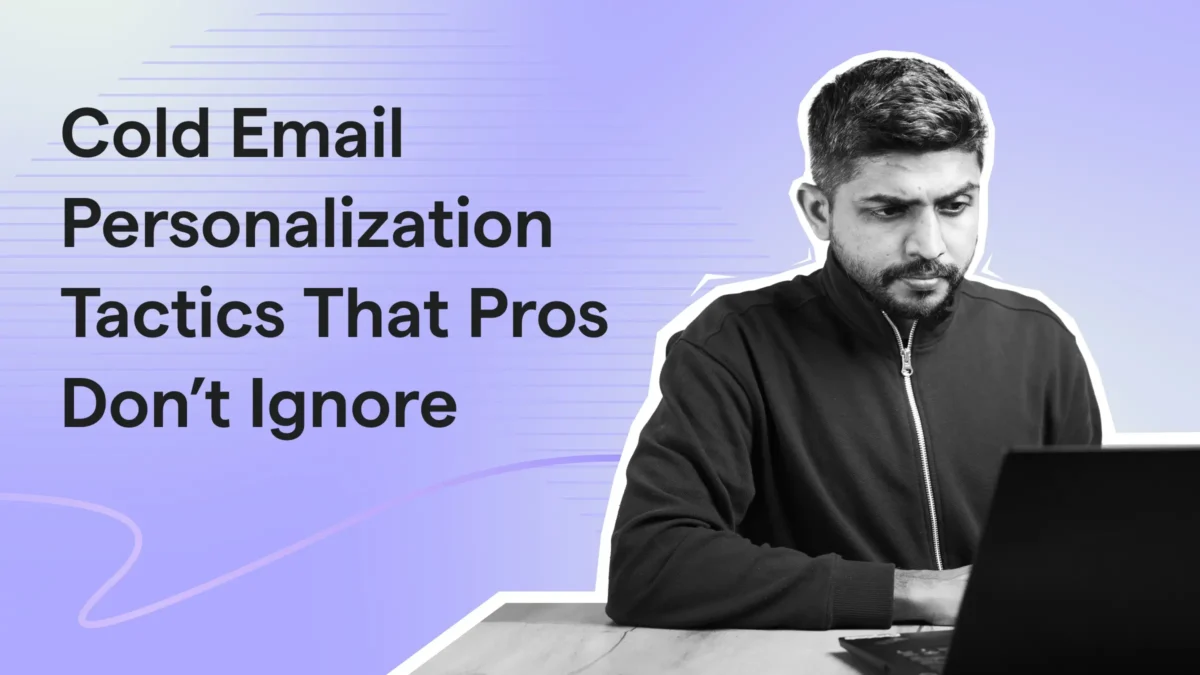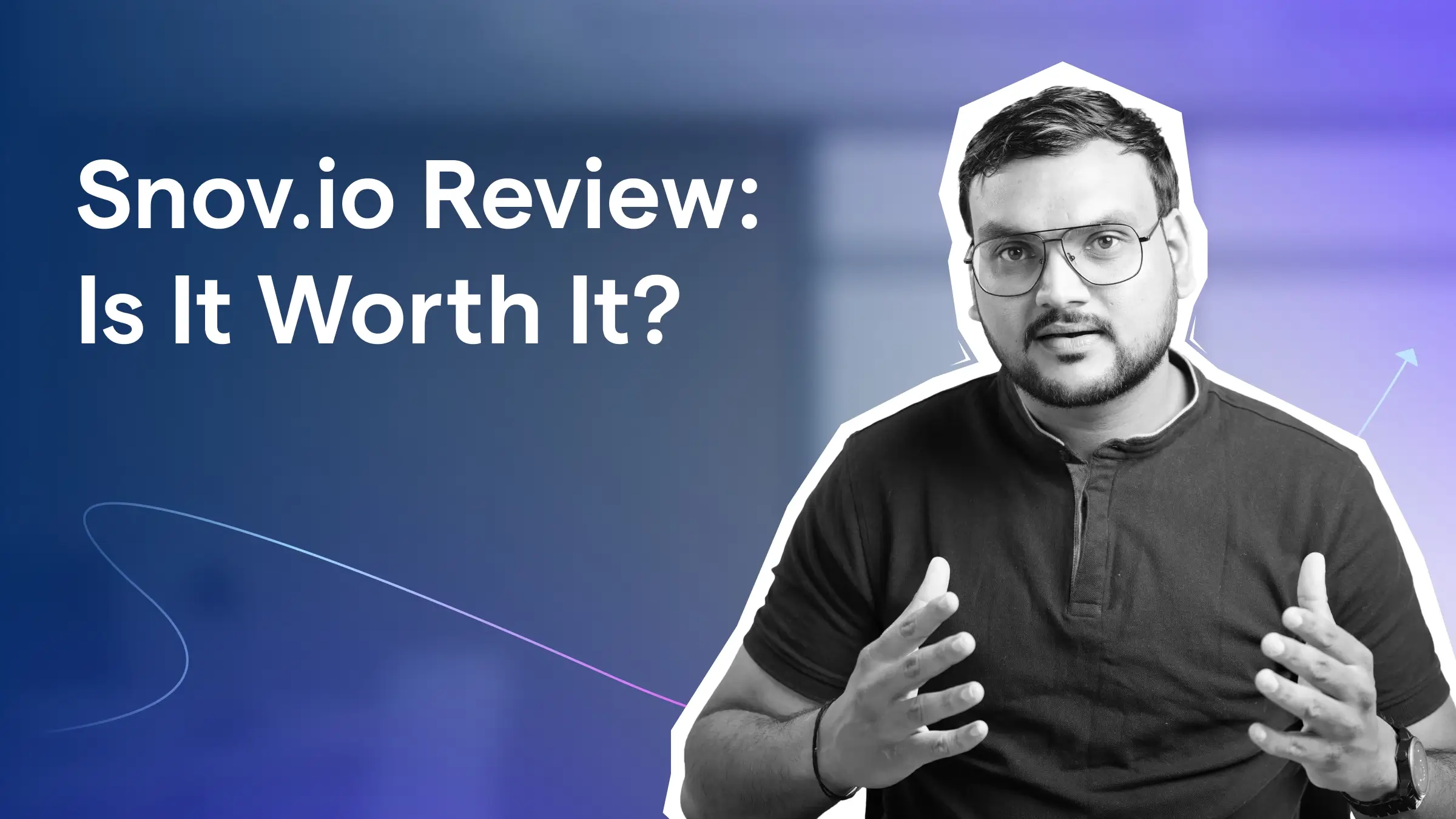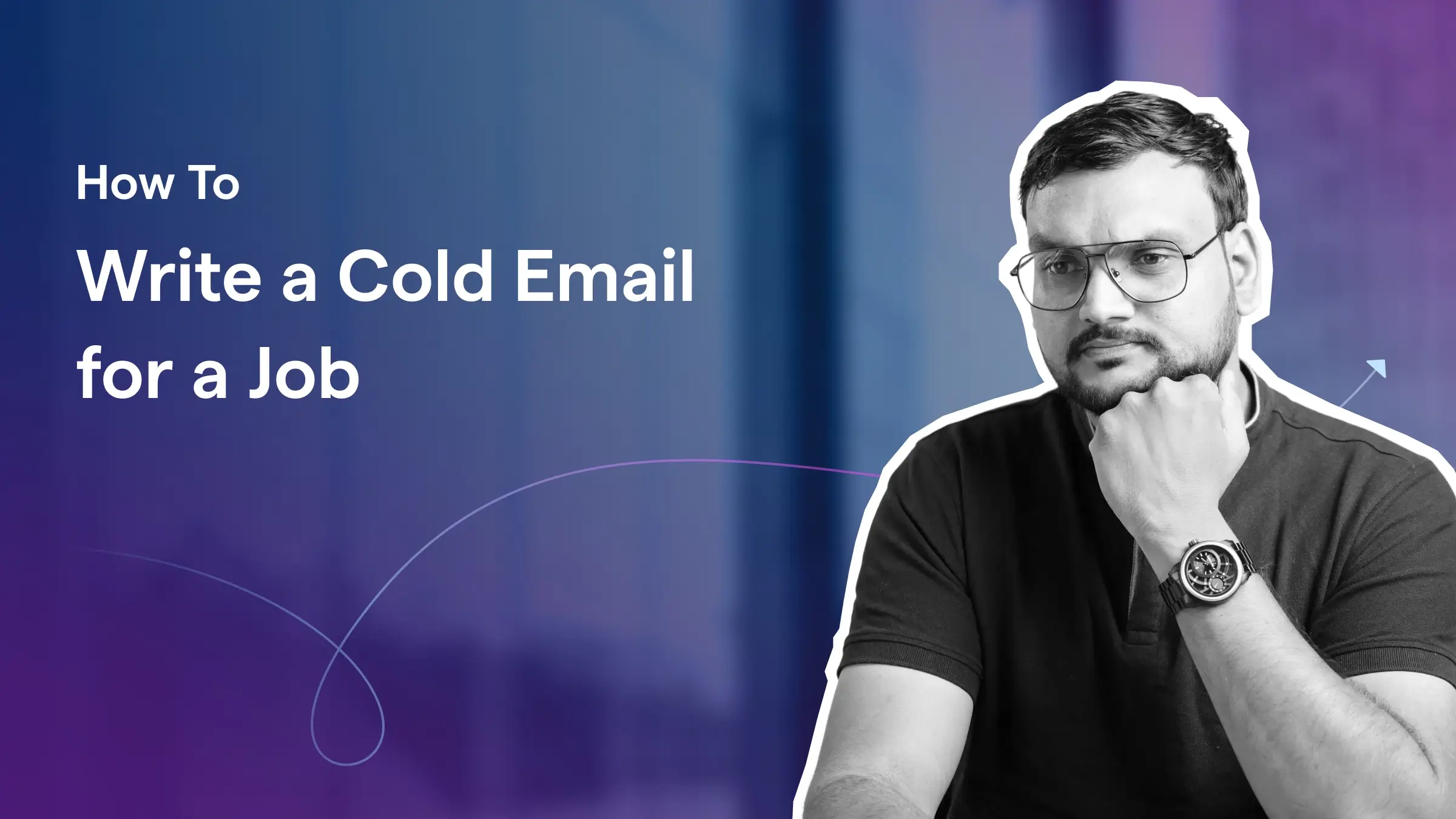Contents
- 1 30-Sec Summary
- 2 Cold Email Personalisation – TOC
- 3 Why Does Cold Email Personalization Matter?
- 4 The 3-Tier Personalization Framework
- 5 Personalization Tactics That Work Best for Your Cold Emails
- 6 How to Personalize Your Cold Emails?
- 7 What Are The Common Cold Email Personalization Mistakes to Avoid
- 7.1 1. Using Irrelevant or Outdated Personal Details
- 7.2 2. Forgetting to Align Personalization With the Prospect’s Pain Point
- 7.3 3. Making It Sound Like a Mail-Merge Instead of a Human Message
- 7.4 4. Personalizing the Intro but Keeping the Rest Generic
- 7.5 5. Using Fake Flattery or Forced Compliments
- 7.6 6. Ignoring Context (like industry, role, or timing)
- 7.7 7. Not Testing Variations Before Scaling
- 7.8 8. Failing to Keep It Concise (Personalized ≠ Long Email)
- 8 How to Measure ROI of Cold Email Personalization?
- 9 Cold Email Personalization TL;DR
- 10 FAQs on Cold Email Personalization
- 10.1 Q1. What is the best way to personalize a cold email?
- 10.2 Q2. How much personalization is enough in a cold email?
- 10.3 Q3. Can personalization be automated without sounding robotic?
- 10.4 Q4. What are common mistakes in cold email personalization?
- 10.5 Q5. How do you measure if personalization is working?
30-Sec Summary
Cold email personalization has moved beyond {{First Name}}.
Now it is about making your prospects feel interested and providing value to them.
In this blog, you’ll come across various tactics to help you write personalized cold emails.
You’ll also see:
- How Saleshandy’s smart features can create endless personalized emails without putting in manual work.
- What common mistakes can you avoid to make your cold email reach inboxes?
- What ROI can you expect from cold email personalization?
Think about the last time someone remembered your name at the first meeting.
It caught your attention, right?
That’s precisely what personalization does in cold emails: it makes you pause, notice, and feel seen.
Whenever you reach out to someone you don’t know, a personalized cold email can leave a lasting impression and open the door to further conversation.
So the real question is: how do you personalize effectively without crossing into overkill or wasting hours on manual edits?
This guide has covered it all.
Let’s get started.
Cold Email Personalisation – TOC
- Why Does Cold Email Personalization Matter?
- The 3-Tier Personalization Framework
- Personalization Tactics That Work Best for Your Cold Emails
- How to Personalize Your Cold Emails?
- What Are The Common Cold Email Personalization Mistakes to Avoid
- How to Measure ROI of Cold Email Personalization?
- Cold Email Personalization TL;DR
- FAQs on Cold Email Personalization
Why Does Cold Email Personalization Matter?
Think of your own inbox for a second. You probably would’ve ignored thousands of emails that were either looking the same or very generic.
However, some emails would still have caught your attention.
Chances are that it contained your name, something about your role, or a problem you are dealing with.
That’s the power of personalization. It just doesn’t grab attention; it earns the right to a reply.
Here’s why personalization makes or breaks your cold outreach:
- People reply to relevance, not templates – A prospect will ignore 10 generic emails, but answer the one that actually speaks to their world.
- It builds instant trust – When you show that you’ve done your homework, you come across as credible, not spammy.
- It moves conversations forward – Personalization isn’t just about “Hi [First Name].” It’s about showing you understand their problems, so your solution feels catered and valuable.
- It’s your unfair advantage – Most people claim to personalize, but often stop at a name tag. Going one level deeper can instantly put you in the top 10% of cold emails that actually get replies.
Personalization matters because it transforms your email from an interruption to a relevant conversation starter. And in an inbox full of noise, that’s how you win attention, replies, and meetings.
The 3-Tier Personalization Framework
Personalization doesn’t just mean including the recipient’s name in your cold email; it’s more than that.
I have framed a 3-tier personalization framework that can help you personalize as per your ICPs, making your outreach campaign successful.
Tier 1: Basic Personalization With Contextual Details
This is the starting point of your personalized campaigns. It includes adding the name, company, and job title of your prospects.
This is ideal if you are targeting a large list of leads, but still want to sound genuine and human.
For Example- “Hi Jimmy, I noticed you work at Acme Corporation.”
This will give your prospects the impression that you know them, making you sound less salesy and robotic.
Tier 2: Role-Specific & Event-Based Personalization
Here’s where you start standing out. Instead of just a name, you connect your email to what’s actually relevant to them or issues they are facing.
It’s less about simple personalization and more about addressing their issues.
For Example- “Congratulations, Jimmy! I’ve noticed that your company is scaling up rapidly, but securing leads can still be a challenge. We can help!”
This approach works best when targeting mid-value prospects who are more likely to respond if you address their specific needs directly.
Tier 3: Hyper-Custom Personalization for High-Value Accounts
This is the highest level of personalization. Although it is time-consuming and not feasible for a large number of prospects, it can be performed for high-revenue clients.
It makes the prospect feel like you wrote the email only for them, which massively boosts response rates.
For Example- “Hi Jimmy, I saw your podcast about how Acme deals with its competitors, and there you mentioned some pitfalls.We have also helped our clients deal with the same issue.Let’s connect and get this issue done!”
It is best reserved for high-value stakeholders, where extra effort brings major payoffs.
Personalization Tactics That Work Best for Your Cold Emails
- How to Personalise Subject Lines That Boost Open Rates?
- How to Craft Intro Lines That Instantly Hook Prospects?
- How to Write CTAs That Feel Relevant, Not Generic?
Personalization is not only about adding the recipient’s name or minor details, but also about crafting a well-structured email that feels like you are speaking directly to them.
I have segmented personalization of cold emails into three key elements that ensure your email gets opened or replied to.
How to Personalise Subject Lines That Boost Open Rates?

Subject lines are the first thing your recipients notice when your email lands.
If you fail to catch their attention in those 2-5 seconds, then your email is dead for them.
Always ensure your subject line is catchy and concise, consisting of no more than seven words.
Subject line examples:
- Congratulations on your Series-A funding – Quick Idea!
- {{First Name}}, your work caught my eye— let’s chat!
- {{First Name}}, may I introduce myself briefly?
How to Craft Intro Lines That Instantly Hook Prospects?

If your subject lines caught attention, then your intro should maintain the curiosity.
Email intros should be no longer than 20 words.
Take a moment to learn a bit about the person you’re emailing. It shows you’re intentional, not just blasting names from a list.
Intro line examples:
- Congrats on Acme’s Series B! Fast growth always brings new sales ops challenges.
- In SaaS, most teams struggle to achieve reply rates above 5%. Wondering if you’re seeing the same?
- Loved your post on building predictable revenue — curious how you’re applying it at Acme.
How to Write CTAs That Feel Relevant, Not Generic?

A soft nudge or CTA (call to action) at the end of your email ensures your prospects are not leaving empty-handed.
You should always use low-pressure CTAs that feel natural after a conversation. Don’t ask for a 30-minute call straight away.
Your aim should be to provide recipients with value at the end of your cold email.
CTA Examples:
- Let’s hop on a quick chat to discuss this further.
- Would you like a short demo to help you achieve {{Goal}}?
- Would you like me to send a detailed report on this matter?
By following these tactics, you’ll be able to create cold emails that are hyper-personalized, align with your prospect’s intent, and yield high response rates.
How to Personalize Your Cold Emails?
When you have a long list of leads to reach out to, doing it manually doesn’t make sense. That’s where cold email personalization and automation tools step in to save the day.
This is where tools such as Saleshandy come in handy, helping you scale personalization while keeping things efficient.
Let’s understand each in detail.
1. Start with a Segmented Lead List
2. Use a Blend of Merge Tags, Variable Tags, and AI for Personalized Outreach
3. Create Role-Specific Email Sequences for Different Personas
4. Tracking Opens, Replies, and Optimizing Personalization Over Time
1. Start with a Segmented Lead List

Personalization only works if your list is clean and targeted.
Upload a CSV file in Saleshandy or find leads using 10+ filters, such as role, industry, or company size. The tighter your segmentation, the easier it is to sound relevant.
2. Use a Blend of Merge Tags, Variable Tags, and AI for Personalized Outreach

Always go beyond {{FirstName}}, use merge tags, Spintax, and role-specific variables to adapt each email naturally.
This way, your outreach looks personalized, especially for them, without putting in manual work.
Also, use Saleshandy’s AI Variant feature to test different email copies for the same sequence
3. Create Role-Specific Email Sequences for Different Personas

You should know that every prospect is not the same and you can only aim for engagement when you have catered to the needs and provided value to each of your recipients, irrespective of their role.
This makes it essential to build separate sequences for different personas.
With Saleshandy, you can set up role-based variables and personalize at scale, so your emails highlight what matters most to each audience.
Additionally, using AI Variants, you can test different messaging styles across personas and quickly determine what resonates best.
4. Tracking Opens, Replies, and Optimizing Personalization Over Time

Personalizing cold emails is an ongoing process, and with Saleshandy’s powerful tracking system, you can easily see how your campaigns are performing.
From open rates, reply rates, to link clicks, you’ll know exactly which of your cold emails are working and which one needs improvement.
On top of that, Saleshandy’s A to Z testing feature lets you experiment with subject lines, intros, and CTAs for better results.
Spoiler alert: Saleshandy is rolling out an AI Enrichment feature that will take personalization to the next level and help you run smarter campaigns.
What Are The Common Cold Email Personalization Mistakes to Avoid
When crafting ideal cold emails, it’s essential to avoid common mistakes that can significantly impact your response rates. Let’s understand each of them in detail.
1. Using Irrelevant or Outdated Personal Details
2. Forgetting to Align Personalization With the Prospect’s Pain Point
3. Making It Sound Like a Mail-Merge Instead of a Human Message
4. Personalizing the Intro but Keeping the Rest Generic
5. Using Fake Flattery or Forced Compliments
6. Ignoring Context (like industry, role, or timing)
7. Not Testing Variations Before Scaling
8. Failing to Keep It Concise (Personalized ≠ Long Email)
1. Using Irrelevant or Outdated Personal Details
Personalization only works in your favour when it is relevant and updated about your prospects. Using irrelevant and outdated personal details will reveal your lack of interest and can easily mislead your recipients.
How to Avoid it:
Use recent and relevant information about the prospect that relates to their role or situation.
It is best to use an updated B2B database or lead list for better outreach.
2. Forgetting to Align Personalization With the Prospect’s Pain Point
If your cold email is personalized but doesn’t address the pain points of your recipients, it holds no value for them.
It fails to spark any interest in your prospect, thereby nullifying the purpose of cold emailing.
How to Avoid it:
Connect every personalized detail to a real challenge or goal your prospect cares about.
3. Making It Sound Like a Mail-Merge Instead of a Human Message
Automation is necessary when mass emailing, but overly automated messages can lose their human touch and be ignored.
Thus, it is essential to automate your cold emails while also maintaining a personal touch to convey sincerity and genuine interest.
How to Avoid it:
Keep your tone natural, as if you are speaking to that person.
4. Personalizing the Intro but Keeping the Rest Generic
After crafting a compelling subject line and introduction, if the rest of your email remains generic, it will fail to create the desired impact.
This mistake is also known as “the personalized hook and run. You start with a great hook, and then your email turns into a generic sales pitch.
How to Avoid it:
Carry the personalization throughout your email, including CTA and not just the subject line and intro.
5. Using Fake Flattery or Forced Compliments
Compliments and appreciation are good when they sound genuine.
Refrain from using insincere praise, which can make your email look flaky and forced.
How to Avoid it:
Keep your personalization honest and relevant, and skip unnecessary flattery that doesn’t add any value.
6. Ignoring Context (like industry, role, or timing)
In this era, generic personalization will not yield the desired results.
To run a successful cold email campaign, ensure your personalization includes job roles, industry insights, and other specific details.
How to Avoid it:
Craft messages that include your prospect’s position, industry, and current situation.
7. Not Testing Variations Before Scaling
This is one of the most significant and common mistakes people make when running cold email campaigns.
Untested emails result in wasted efforts and low reply rates.
Testing variations of cold emails before scaling helps you understand what works for you and what doesn’t.
How to Avoid it:
Test different intros, subject lines, and CTAs with a smaller list before sending to a larger group of people.
8. Failing to Keep It Concise (Personalized ≠ Long Email)
It is reasonable to explain why you are reaching out to someone, but it is also crucial to convey this information in a subtle and concise manner.
Over-personalized and over-explained emails often end up unopened.
How to Avoid it:
Keep your cold emails short, sharp, and focused, and don’t make your recipients read too much.
Also, check out our guide on the top AI email personalization tools for better engagement.
How to Measure ROI of Cold Email Personalization?
All of this boils down to one question: What do we gain after investing this much effort into cold email personalization?
And that’s a valid question.
Let’s understand the ROI of personalized cold emails.
What metrics should you monitor:
- Reply Rate Per Personalization
If your personalized emails are landing well, you’ll see more replies compared to generic emails.
Track how different levels of personalization (basic, role-specific, hyper-custom) affect response rates. This shows you what type of effort is worth scaling.
- Meetings Booked Per CTA Variation.
Personalization doesn’t end after getting a reply. It should slowly move the prospect from relying on booking a meeting and eventually turning into a potential customer.
Monitor how many meetings are being booked when you tweak CTAs with relevance to your prospect’s role and needs.
This will help you identify which CTAs are driving conversions.
- Time Saved Vs Manual Edits
Personalization can be time-consuming if done manually.
Measure the time you save by automating your outreach, such as using merge tags, Spintax, and sequence setup.
You can also compare it with manual sending to determine whether personalization is scalable or simply consuming your resources.
Cold Email Personalization TL;DR
- Relevance wins: Personalization isn’t just about adding {{FirstName}} — it’s about showing you understand the prospect’s context.
- Follow the 3-tier framework: Start with basics (name, role), move to role/event triggers, and reserve hyper-custom lines for high-value accounts.
- Tactics that convert: Personalize subject lines to boost opens, intros to hook instantly, and CTAs to feel relevant (not generic).
- Avoid common mistakes: Don’t use outdated info, fake flattery, or generic intros that ruin authenticity.
- Measure what matters: Track reply rates, meetings booked, and time saved to know if personalization is paying off.
- Scale with Saleshandy: Upload & segment leads, use Spintax for variations, build role-specific sequences, and optimize with reply tracking.
FAQs on Cold Email Personalization
Q1. What is the best way to personalize a cold email?
The best approach is to combine basic details about your prospect (name, job role, company) with role-specific pain points. A short, relevant intro line plus a clear CTA makes personalization feel genuine, not forced.
Q2. How much personalization is enough in a cold email?
You should never overdo personalization. One or two personalized elements (such as a recent company milestone or role-specific challenge) are enough to make your email stand out without making the email bulky.
Q3. Can personalization be automated without sounding robotic?
Yes. Using tools like Saleshandy, you can automate with Spintax, role-based sequences, and merge tags while still keeping each email natural and human.
Q4. What are common mistakes in cold email personalization?
Some common mistakes include relying solely on first-name tags, using outdated information, writing lengthy introductions, or personalizing the opener while leaving the rest of the email generic.
Q5. How do you measure if personalization is working?
Track reply rates, meetings booked, and time saved compared to manual sendings. If personalization isn’t improving replies, refine your subject lines, intros, or CTAs.







